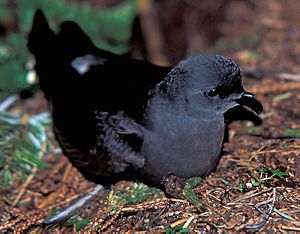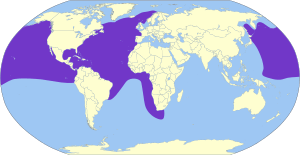Leach's storm petrel facts for kids
Quick facts for kids Leach's storm petrel |
|
|---|---|
 |
|
| Conservation status | |
| Scientific classification | |
| Genus: |
Oceanodroma
|
| Species: |
leucorhoa
|
| Subspecies | |
|
See text |
|
 |
|
The Leach's storm petrel (scientific name: Oceanodroma leucorhoa) is a small seabird. It belongs to a group of birds called "tubenoses" because of their unique nostrils. This bird got its name from a British animal expert, William Elford Leach.
Its scientific name comes from Ancient Greece. Oceanodroma means "ocean runner," and leucorhoa means "white rump." This describes the bird's white patch above its tail.
Leach's storm petrels build their nests on islands that are hard to reach. They prefer colder parts of the Atlantic Ocean and Pacific Ocean. They nest in large groups near the sea. They hide their nests in places like cracks in rocks, shallow holes, or even inside logs. Each pair lays just one white egg. This egg often has a faint ring of spots.
These birds are mostly active at night when they are at their nesting sites. This helps them avoid being caught by predators like gulls and skuas. They even avoid landing on clear, moonlit nights to stay safe. The biggest group of Leach's storm petrels lives on Baccalieu Island in eastern Canada. More than 3 million pairs of these birds live there!
Contents
What Does a Leach's Storm Petrel Look Like?
Leach's petrels are small birds. They are about 18 to 21 centimeters (7 to 8 inches) long. Their wings can spread out to 43 to 48 centimeters (17 to 19 inches).
Like many other storm petrels, they have dark feathers all over their body. They usually have a white patch above their tail, called a rump. However, some birds on the west coast of North America have a dark rump instead.
In Europe, it's easy to tell them apart from other storm petrels. They are bigger and have a forked tail. They also have a different white rump pattern and fly in a special way. In the Americas, it can be harder to identify them.
These birds have a fluttering flight. They seem to "walk" on the water's surface as they pick up tiny food items. Like most petrels, they can only shuffle short distances on land to get to their nests.
Types of Leach's Storm Petrels
There are two main types, or subspecies, of Leach's storm petrels:
- O. l. leucorha — Found along the coasts of the North Pacific and North Atlantic.
- O. l. chapmani — Found near the Coronado Islands and San Benito Island in Mexico.
Where Do Leach's Storm Petrels Live?
Outside of the breeding season, these birds live far out at sea. This, along with their hidden nesting spots, makes them hard to spot from land. You might only see them near land during strong storms. Unlike some other seabirds, they do not follow ships.
In Europe, one of the best places to see them is in Liverpool Bay in September. Strong winds can push these migrating birds into this bay.
Life Cycle and Habits
These small birds live for a surprisingly long time. On average, they live about 25 years. The oldest known Leach's storm petrel lived for over 38 years! Scientists have found that a part of their cells, called telomeres, actually get longer as they age. This is very unusual and might help them live longer.
Leach's storm petrels mostly eat tiny ocean creatures called plankton. This includes small shrimp-like animals and other tiny sea bugs. They also eat small fish called lantern fish, which come to the surface at night. These birds can fly very far to find food, sometimes up to 1,000 kilometers (620 miles) from their nests.
When a parent bird is nesting, it stores special energy-rich fats in a pouch. This fat helps them survive while sitting on their egg. They also use it to feed their chick. If a predator tries to catch them, they can even spit out this oily substance as a defense.
Sadly, parent birds sometimes accidentally feed their chicks small pieces of plastic. They mistake this plastic for food floating on the ocean's surface. Chicks grow very big before they leave the nest. They can weigh almost twice as much as when they finally fly away in late September.
During their long journey, they travel to warm ocean currents. Strong storms in the fall can sometimes cause young birds to get lost and end up on the mainland.
See also
 In Spanish: Oceanodroma leucorhoa para niños
In Spanish: Oceanodroma leucorhoa para niños



